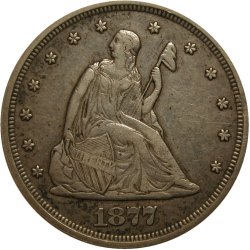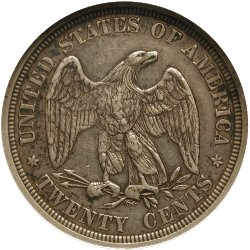4 Collecting Double Dimes
A complete set of twenty-cent pieces consists of 5 circulation strikes issued in 1875 and 1876 plus the proof coins struck from 1875-1878, with the last two years as proof-only issues.
One of the circulation strikes, the 1876-CC, is an extreme rarity. Nearly the entire production run of the 1876-CC was unreleased, and was subsequently melted in 1877. Only a couple
dozen pieces were originally preserved and thus escaped the melting pot. However, the actual number of examples saved from melting is not known. A precious few entered circulation,
and surely some were lost to attrition. This coin is excessively rare with several examples in museum collections. As such, the 1876-CC is generally considered non-collectible (NC)
and excluded from a circulation set that most collectors can strive to assemble.
The vast majority of collectors of U.S. coins have chosen to collect this series by type. That is, they choose to only have a single example of the series. Commonly, the
twenty-cent piece is part of an “odd denomination” set along with a 2-cent piece, silver 3-cent piece, and nickel 3-cent piece.
Others want a coin from each mint, or perhaps the four regular issue circulation strikes (excluding the 1876-CC). Still others collect the proofs from each year. An increasing
number of collectors, however, are collecting the entire series, including the four circulation strikes, plus the two proof-only issues.
The following discusses the different manners of collecting double dimes, and offers some options and suggestions.
Type Collecting
If a collector wishes only a single example, the most readily available and affordable is the 1875-S. This particular issue is always available in all grades, including mint state, and won’t break the budget.
For relatively few dollars more, two alternatives to the 1875-S are the Philadelphia issues from 1875 and 1876. These very low-mintage coins are much scarcer than the 1875-S and really don’t cost
all that much more. If the collector wishes to have a truly scarce date for their type coin, then this is the way to go. When shown to other collectors, most people assume the type twenty-cent
piece will be an 1875-S and often they will be surprised when shown a coin struck in Philadelphia, especially if from 1876.
For the Carson City enthusiast, the 1875-CC is the obvious type coin, but you will pay a lot more for this coin. This issue is not scarce as a date, but is facing huge demand and thus is the most
expensive of the four circulation strikes. The good news is that you will have no problem finding one. And the result will be a type coin that is not the very common 1875-S.
Some collectors may wish to obtain a type coin in proof format. To meet this goal, each of the proof issues from 1875 to 1878 are available. However, the 1877 and 1878 are proof-only issues with
very limited mintages and thus will be much more costly. Still, having a key date of a series as one’s type coin is of interest to many people, and the 1877 or 1878 certainly fit the bill.
Therefore, if a collector wishes a single type coin to represent the series, there are numerous choices, depending on the collector’s interest and budget. The 1875-S will give you the nicest coin
for the money, either the 1875 or 1876 will give you the scarcest coin for the money, and the 1875-CC will give you the CC mintmark many people crave. And any of the proofs will give you the
best look. Certainly the best buy right now is either Philadelphia issue.
Collecting the Proofs
The four regular issue proofs, 1875-1878, are readily available, and can often be found well preserved. The proof coins do come with a high price, especially the 1877 and 1878 and as more
collectors seek out complete sets, these coins will become very difficult to find.
All of these dates will appear at larger coin shows, but more frequently at auction. A collector will not have as much competition for the 1875 and 1876 proofs as for the two later
proof-only dates. Impaired and/or cleaned proofs of all years are frequently encountered and command a significant discount.
Still, collectors wishing to obtain all four dates in proof format will not have much trouble, even if it may take a little time to find the right example for any particular date.
Building a Complete Set
The complete set of regular issues comprises four circulation strikes and two proof-only coins. Unless you are building a Choice-Gem mint state set, the 1877 and 1878 will be your
biggest challenge and the costliest additions to your collection. You can expand the set to include the 1875 and 1876 proofs in addition to their circulation strike counterparts
of the same years if you wish. Most collectors do not do this.
However, if one is trying to build a nice, well-matched, circulated, complete set, this will provide a great challenge because of the difficulty in finding circulated examples of
the 1877 and 1878 proof-only issues. Increasing numbers of collectors building XF-AU sets want to find the two proof-only dates in similar condition.
Proofs: Impaired versus Circulated
Once upon a time, any proof coin that was not in its original condition was considered impaired. This included a wide range of afflictions, ranging from cleaned or polished coins, pieces that were
mishandled, damaged, used for jewelry, and in some cases, circulated.
Times are different now, and much of the collecting public has discovered that sometimes a proof coin was merely spent -- either somebody needed the money, or somebody raided a coin collection
without the owner’s knowledge or permission. The realization that one can have a completely original, problem-free, circulated proof coin, has changed the collecting of this series.
 |
 |
|
Original 1877 circulated proof |
Trying to form a nicely matched, attractive, set of circulated coins leads to intense demand for the very few proofs that were placed into circulation and along the way avoided being cleaned,
polished, or otherwise damaged.
Collectors seeking a matched, circulated set have to decide whether to initially acquire a nice proof, or perhaps an impaired proof if they can find one, or wait many years to find that nice
circulated example they’ve been looking for. The authors know several people still looking for attractive circulated 1877 and 1878 coins.
Adding a Pattern or Two
Another way to expand your collection of twenty-cent pieces is to add one or more of the patterns, as discussed in Chapter 2. Also, those building a complete
set are sometimes intrigued enough about the series that they wish to include the patterns, as the pattern pieces help tell the story of the series and its evolution.
Adding a twenty-cent pattern will be very challenging, more so than some other series, as most of these patterns are rare with only a few of each minted. Still, some of the patterns
are available on occasion, and a collector that really wants one will eventually find it.
Varieties and Die Marriages
A variety is a coin that has a unique characteristic about it, different than a “normal” coin, such as a misplaced date, repunched mintmark, doubled die, etc.
A die marriage is simply the combination of one obverse (head) die with a reverse (tail) die, with each die being unique in some way (date position, mintmark
position, variety, die scratches, etc.).
In a short series such as the twenty-cent piece, another way to make it more challenging is collecting varieties, die marriages, and die states. For most of the dates in this
series, this is not difficult, as the small mintages mean only a small number of die marriages were used. Furthermore, very late die states of these scarcer dates (lots of die
cracks, etc.) simply don’t exist. For example, if less than 16,000 coins dated 1876 were made, how many dies were used, and how badly could those dies have deteriorated with
different stages of die cracks, breaks, and other damage?
On the plus side, the most common date in the series, 1875-S, presents at least 16 different die combinations, some with repunched mintmarks (RPMs) and misplaced dates (MPDs).
Many of the dies also developed varying degrees of die cracks and breaks. Identifying a progression of these die cracks is possible with some very diligent searching. The
misplaced dates and one of the RPMs are well known, and can be found without difficulty. One combination even provides a wide range of rotated dies!
The good news is the most interesting of these varieties and late die states are found on the 1875-S, so purchasing them likely won’t break the bank, if you can find them. Hopefully
this book will be a helpful guide in this quest. In the end, this short series presents a real opportunity for one to build a complete die-marriage set, something that might be
prohibitive in most other Liberty Seated series.
As Challenging as You Want
In summary, there are a number of different ways to collect this series. It is up to you to choose what’s right for you, based on your level of interest, the challenge, your time, and of course, your budget.
Any way you approach it, you can enjoy this unusual and short-lived denomination that is more popular now than when it failed as a circulating coin. Good luck and happy hunting!
